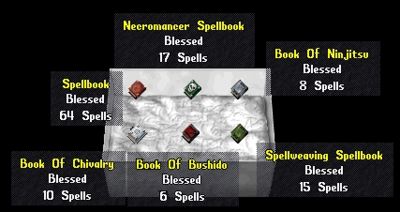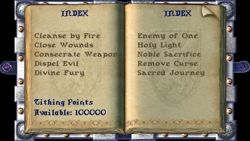Difference between revisions of "Spellbook"
m (resize thumbs) |
Michael XIII (Talk | contribs) |
||
| Line 1: | Line 1: | ||
[[Image:Spellbooks.jpg|thumb|400px|The 6 types of spellbooks.]] | [[Image:Spellbooks.jpg|thumb|400px|The 6 types of spellbooks.]] | ||
[[Image:Book_of_Chivalry_open.jpg|thumb|250px|An open spellbook, the Book of Chivalry.]] | [[Image:Book_of_Chivalry_open.jpg|thumb|250px|An open spellbook, the Book of Chivalry.]] | ||
| − | Though often considered the purview of Mages alone, '''Spellbooks''' are, in fact, the armament for six different templates: [[Magery|Mage]]; [[Necromancy|Necromancer]]; [[Ninjitsu|Ninja]]; [[Chivalry|Paladin]]; [[Bushido|Samurai]]; and [[Spellweaving|Spellweaver]]. The game mechanic known as a spellbook serves the needs of a variety of templates, so not all of the spells contained within can be considered traditional magic. The bushido “spell” of [[Counter Attack]] is far more like a [[Special Move]] than a magic spell. | + | Though often considered the purview of Mages alone, '''Spellbooks''' are, in fact, the armament for six different templates: [[Magery|Mage]]; [[Necromancy|Necromancer]]; [[Ninjitsu|Ninja]]; [[Chivalry|Paladin]]; [[Bushido|Samurai]]; and [[Spellweaving|Spellweaver]]. The game mechanic known as a spellbook serves the needs of a variety of templates, so not all of the spells contained within can be considered traditional magic. The [[bushido]] “spell” of [[Counter Attack]] is far more like a [[Special Move]] than a magic spell. |
| − | The first two pages of every spellbook contain an index of the contents. The | + | The first two pages of every spellbook contain an index of the contents. The [[Paladin]]’s [[Book of Chivalry]] also lists the [[Chivalry|Tithing Points]] a character has on the front page. The pages of a spellbook are turned by clicking the curled page in the upper right-hand corner. A character may also turn directly to the spell desired by clicking on the name of the spell. To return to the index page, simply reopen the spellbook. |
| − | Both the Magery and the Spellweaving spellbooks begin with no spells. Spells are added to such spellbooks by dropping an appropriate [[Scrolls|scroll]] onto the spellbook in question. Low level magery spell scrolls can be purchased from [[NPC]] | + | Both the [[Magery]] and the [[Spellweaving]] spellbooks begin with no spells. Spells are added to such spellbooks by dropping an appropriate [[Scrolls|scroll]] onto the spellbook in question. Low level magery spell scrolls can be purchased from [[NPC|NPCs]] that are located in town magery shops, while high level scrolls can be found as loot on certain monsters. Obviously, scrolls can be crafted by practitioners of the [[Inscription]] skill who also have enough Magery. For this reason, player [[vendor|vendors]] also sell spell scrolls. |
| − | Spellweaving spell scrolls primarily are gotten from Elfish quests in the [[Heartwood city|City of Heartwood]]. However, player vendors sometimes carry them. Two of the spells can only be gotten via quest, the spells [[Summon Fey]] and [[Summon Fiend]]. | + | Spellweaving spell scrolls primarily are gotten from [[elf|Elfish]] [[quest|quests]] in the [[Heartwood city|City of Heartwood]]. However, player vendors sometimes carry them. Two of the spells can only be gotten via quest, the spells [[Summon Fey]] and [[Summon Fiend]]. |
| − | Magery spellbooks are [[Crafting|craftable]], and as such can contain powerful [[Item Properties|modifications]]. There are also artifact/über-crafted spellbooks for both Mages and Necromancers. Mages have 4: [[Clainin%27s_Spellbook|Clainin’s Spellbook]], [[Tome of Enlightenment]], [[Tome of Lost Knowledge]], and [[Scrapper%27s Compendium|Scrapper’s Compendium]]. Scrapper’s Compendium are not artifacts, they are crafted, but [[blessed]]. Of all of the spellbooks, only the Tome of Enlightenment and the Tome of Lost Knowledge are not blessed. To emphasize the incongruity of the two [[Treasures of Tokuno]] artifacts not being blessed, all crafted spellbooks are blessed; even the Necromancer’s only artifact spellbook, the [[Ossian Grimoire]], is blessed... ironically enough. | + | Magery spellbooks are [[Crafting|craftable]], and as such can contain powerful [[Item Properties|modifications]]. There are also artifact/über-crafted spellbooks for both Mages and Necromancers. Mages have 4: [[Clainin%27s_Spellbook|Clainin’s Spellbook]], [[Tome of Enlightenment]], [[Tome of Lost Knowledge]], and [[Scrapper%27s Compendium|Scrapper’s Compendium]]. Scrapper’s Compendium are not [[artifact|artifacts]], they are crafted, but [[blessed]]. Of all of the spellbooks, only the Tome of Enlightenment and the Tome of Lost Knowledge are not blessed. To emphasize the incongruity of the two [[Treasures of Tokuno]] artifacts not being blessed, all crafted spellbooks are blessed; even the Necromancer’s only artifact spellbook, the [[Ossian Grimoire]], is blessed... ironically enough. |
| − | Spellbooks can be dyed. Spellbooks have no weight (no matter how many spells are inside). | + | Spellbooks can be dyed. Spellbooks have no [[weight]] (no matter how many spells are inside). |
[[Category:Spellbooks]] | [[Category:Spellbooks]] | ||
Revision as of 07:12, 21 March 2008
Though often considered the purview of Mages alone, Spellbooks are, in fact, the armament for six different templates: Mage; Necromancer; Ninja; Paladin; Samurai; and Spellweaver. The game mechanic known as a spellbook serves the needs of a variety of templates, so not all of the spells contained within can be considered traditional magic. The bushido “spell” of Counter Attack is far more like a Special Move than a magic spell.
The first two pages of every spellbook contain an index of the contents. The Paladin’s Book of Chivalry also lists the Tithing Points a character has on the front page. The pages of a spellbook are turned by clicking the curled page in the upper right-hand corner. A character may also turn directly to the spell desired by clicking on the name of the spell. To return to the index page, simply reopen the spellbook.
Both the Magery and the Spellweaving spellbooks begin with no spells. Spells are added to such spellbooks by dropping an appropriate scroll onto the spellbook in question. Low level magery spell scrolls can be purchased from NPCs that are located in town magery shops, while high level scrolls can be found as loot on certain monsters. Obviously, scrolls can be crafted by practitioners of the Inscription skill who also have enough Magery. For this reason, player vendors also sell spell scrolls.
Spellweaving spell scrolls primarily are gotten from Elfish quests in the City of Heartwood. However, player vendors sometimes carry them. Two of the spells can only be gotten via quest, the spells Summon Fey and Summon Fiend.
Magery spellbooks are craftable, and as such can contain powerful modifications. There are also artifact/über-crafted spellbooks for both Mages and Necromancers. Mages have 4: Clainin’s Spellbook, Tome of Enlightenment, Tome of Lost Knowledge, and Scrapper’s Compendium. Scrapper’s Compendium are not artifacts, they are crafted, but blessed. Of all of the spellbooks, only the Tome of Enlightenment and the Tome of Lost Knowledge are not blessed. To emphasize the incongruity of the two Treasures of Tokuno artifacts not being blessed, all crafted spellbooks are blessed; even the Necromancer’s only artifact spellbook, the Ossian Grimoire, is blessed... ironically enough.
Spellbooks can be dyed. Spellbooks have no weight (no matter how many spells are inside).

